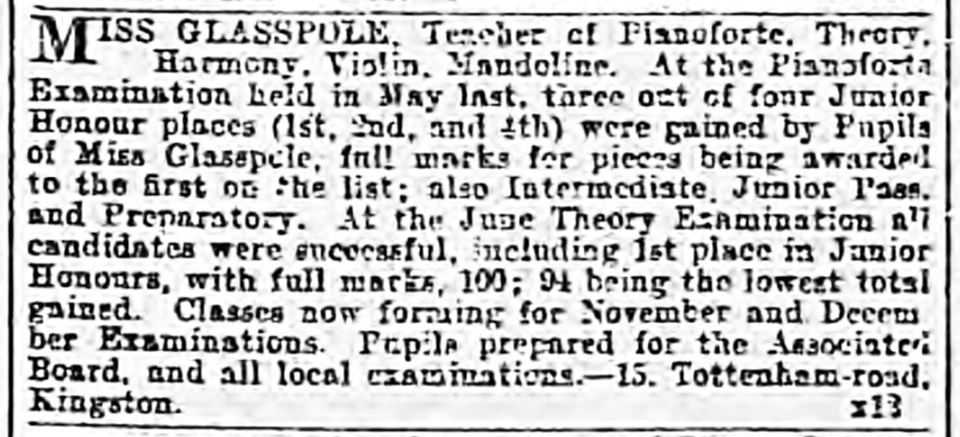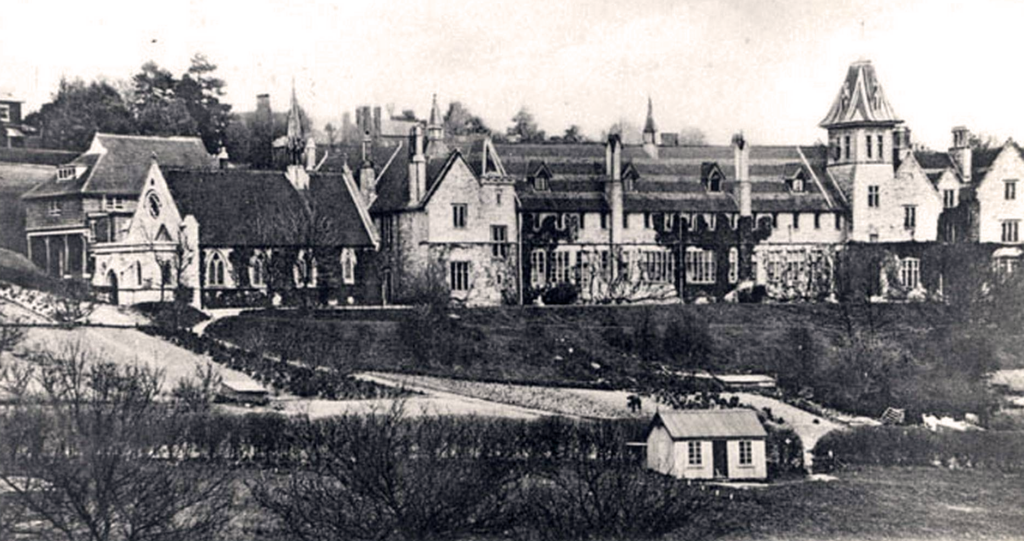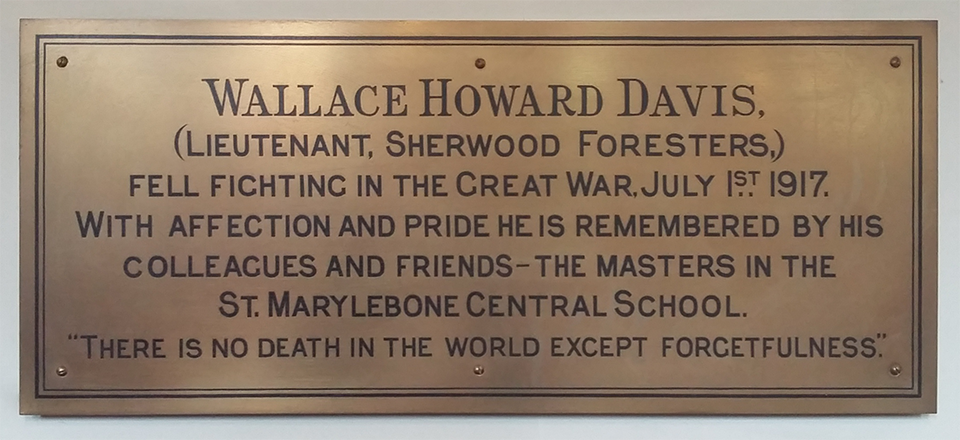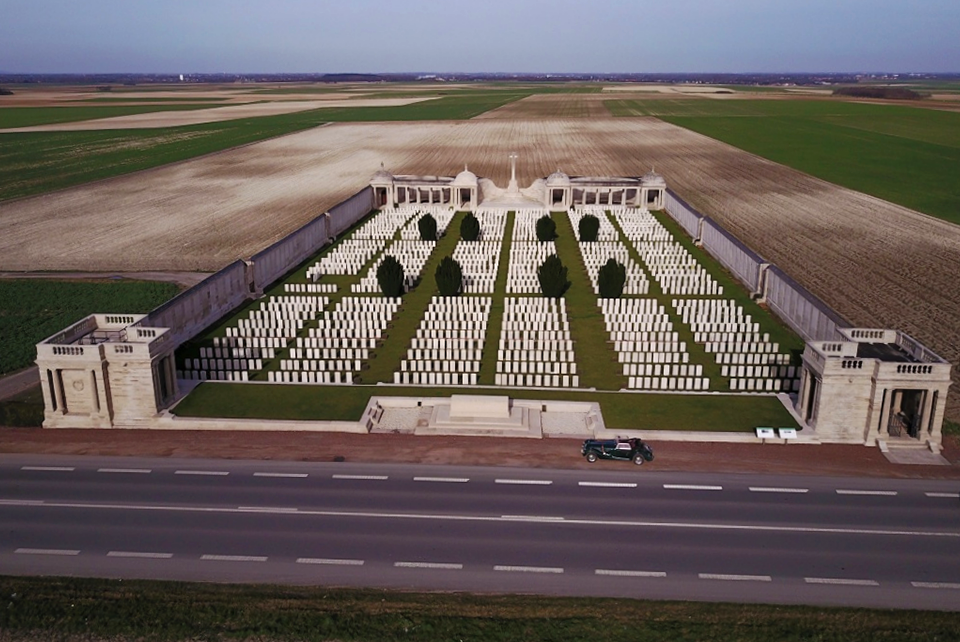2nd Lieutenant Wallace Howard Davis, 23rd London Regiment then 4th Battalion Sherwood Foresters (attached to 2nd Battalion), was killed in action at Lens on the 1st July, 1917, on the Western Front and is commemorated on the Loos Memorial.
Family and Background
Wallace’s grandparents were Glasspoles1 and Davises. The Glasspoles were an old Portsmouth family and the Davises hailed from Gloucester but moved to Portsmouth in 1847. Both families had connections to the sea. Gloucester Docks had opened to sea-going traffic in 1827 so it is not surprising that marine trades were common in the city. His paternal grandfather Mark’s2 occupation as a ropemaker would have made the move to Portsmouth a natural one. Wallace’s maternal grandfather Robert3 was a Royal Navy Engineer, joining at the age of 28 and serving for 19 years in the Mediterranean and China before being Portsmouth based.
Edward James Davis and Sarah Whettem4 Glasspole, Wallace’s parents, married in July 1883 in Portsmouth, aged 30 and 28. Both came from large families: Edward had 5 brothers and 2 sisters, and Sarah 5 brothers and 1 sister. It gives some idea of the background of all Wallace’s parents and aunts and uncles, to list their trades: (Davis) ship’s painter, Royal Navy armourer, sewing machinist, blacksmith, ropewalk supervisor, plumber, Royal Navy painter; (Glasspole) milliner, Royal Navy engineer, Royal Navy navigator, Inland Revenue Clerk, dentist, Royal Navy engineer, music teacher.5 There was a strong bias towards non-manual work on the Glasspole side. Both Edward and Sarah were the third-born children of their families. Edward was a painter in the dockyard and Sarah was a milliner.

On May 17th, 1885, Sarah gave birth to a son, Edward Gordon. The following year Wallace Howard was born, followed in the Summer of 1888 by the last of their children, Sidney Clinton.
It was a social aspiration of many families to see their children take up white-collar positions, or even one of the professions. Edward and Sarah must have been very proud parents to see all three of their boys achieve the latter: all became schoolmasters, as we shall later see.
The three Davis boys were born in Portsmouth. In 1891 they were living at 33 Timpson Road, Fratton, Portsmouth and we know from Wallace’s later college Student Record that he, and therefore most probably his brothers, attended Penhale Road Boys’ School, about a quarter of a mile away. With a birthday of 31st August, Wallace must have been the youngest pupil of his school year.
All members of the family seem to be absent from the 1901 Census but his college Student Record shows his address on entry (1905) to be 17 Frogmore Street, Portsmouth. This newly-built street of bay-windowed houses lay next to the football ground of the nascent Portsmouth Football Club, Fratton Park. The street, club and ground all date from 1898-1899. As the new home was still within walking distance of Penhale Road School, Wallace completed his elementary education there and continued in an appointment as a pupil teacher, probably at the age of 15 (1901). He completed only two years in his old primary school before securing an assistant teacher’s post in London, and moving away from home to work there at the very young age of about 18. His later Commonwealth War Graves Commission record lists him as teaching at All Saints’ Boys’ School, Wandsworth, and Marylebone Central School, and, in 1905, Wallace is stated as living at 64 High Street, Marylebone, London.6 This is the address of St. Marylebone Central School and its attached schoolhouse. It would be from here that he would go on to complete the training required before he could become a certificated teacher.
There is an article that includes information on pupil-teachers and outlines the arrangements for entry into the profession here.
Winchester Training College
Apart from his two years of study, and teaching practice at a Practicing School, there is a lot of information on Wallace’s activities while at college. The student body’s magazine, The Wintonian, covering 1905-1907 when he was there, records a number of events:
Wallace represented College as part of the First XI football team. He played in the Past versus Present Football match, which was won 8-1 by the team representing the Past.
In November, 1906 there is a report on the first College Smoker of the 1906–1907 College year, which was held in the Common Room. The title ‘smoker’ is never explained but from the various reports from across the years it appears to be an enjoyable social evening of planned entertainments and performances. In this particular instance, we read that:
…a very pleasant evening was spent. Among the contributors who ably showed that they possessed much latent talent was Wallace Davis, representing the Seniors.

He also played in the College Cricket team. In a section called Cricket Personal Notes of the magazine Davis was described as a
…blossoming Rhodes7, with a very pretty left-handed action; a useful bat, and a keen fieldsman.
Wallace was awarded his Life Saving Proficiency Certificate, and in the Swimming Sports contest he won the prize for the longest distance swum under water (30 yards). He was also awarded his Swimming Instructors Certificate.
In a new arrangement of College football allowing for all abilities to compete, Wallace was the captain of The Athenians Team. A separate Sports Section of the Wintonian noted that;
Quite the feature of the team has been the manner in which Wally Davis has settled down to the position of centre half. After his first match he appeared as if he had played in that position all his life. He has a splendid command over the ball, and latterly his accurate passing to the wings has been all that could be desired.
As college days drew to a close in the Summer of 1907, Wallace found a position back in London, this time south of the Thames at All Saints’ Boys’ School, Wandsworth. He was required to teach satisfactorily for two years after training, as an assistant-teacher, in order to complete the certification process.
In 1911 the family, less Wallace, are shown as being at Southsea, Portsmouth. The words ‘are shown’ rather than ‘lived’ are quite deliberate. In the 1911 Census return we see both Edward and Sidney recorded as being in the family home at 17 Frogmore Road, Southsea, with mother and father. Both have their occupation listed as ‘Trained Certificated Assistant Schoolmaster’. Edward’s employer is London County Council and Sidney’s is just ‘Council School’. One of the problems faced in researching school teachers is that the census date, which is always the first Sunday of April, often coincides with the school Easter holidays. This presents a difficulty to research, particularly with unmarried teachers, as they may return to the parental home during the holiday. This seems to be the case with Edward since he is recorded as teaching in the employ of London County Council, yet showing on a Portsmouth census return. (He was teaching in Woolwich. Source: National Union of Teachers War Record 1914–1919). He is not entered on the form as a ‘Visitor’, which would normally be the case for someone on a short stay at the address. The directions for completion of the form are ‘State whether Head, or Wife, Son, Daughter, or other Relative, Visitor, Boarder, or Servant.’ He is therefore recorded as ‘Son’ (the most natural description of the relationship) and not ‘Visitor’. However, Sidney, recorded as employed by a ‘Council School’, was teaching in Portsmouth (Source: National Union of Teachers War Record 1914–1919).
Wallace is elsewhere and has his own census record. He was a lodger, single and aged 24 is living in 27 Southfields Road, Wandsworth, London, and is employed as a Schoolmaster by London County Council. Wallace occupied a first-floor room until the death of his landlord, Mr. Mullins, around 1913. His widow took over as landlady and Wallace then took an additional room on the ground-floor (London Electoral Registers). Wallace would continue to live in the Mullins house and teach at the school until the outbreak of war.
Into Action
On 15th September 1914 Wallace enlisted at St. John’s Hill, London S.W.. His papers tell us that he was 5 ft 7½in tall, had a 38½in chest with good eyesight and physical development. Initially he was assigned to the 23rd Battalion London Regiment and saw promotion: to Lance Corporal on 19th October, Corporal on 31st October, and Lance Sergeant on 28th March 1915.
Wallace was promoted to 2nd Lieutenant on Probation, dated April 16th, 1915,8 and moved to the 4th Battalion Sherwood Foresters (Nottinghamshire and Derbyshire Regiment), joining his new unit at Backworth, Newcastle-on-Tyne. The promotion was confirmed (made permanent) on November 8th, 1915.9

Although we do not have a date, it is likely that Wallace would soon have moved on from the 4th Sherwood Foresters, which was a Reserve Battalion, and travelled to the Western front to join the 2nd Battalion.
On 28th September 1916, his unit was in the Lesboeufs/Morval area of the Somme. Wallace was struck by shrapnel, causing an entry wound on the side of his upper right thigh and an exit wound just blow the buttock. The War Diary tells us:
[27th September 1916] The majority of the Battalion are digging tonight on a communication trench from Support to front line. A fairly quiet day.
[28th] Lt. W.H. Davis wounded this morning while with the party on the communication trench.
After initial treatment in the field, he was deemed unfit for service and given leave for recovery and was placed on a hospital ship at Calais for Dover on 4th October. Following hospital treatment, he was given leave on November 3rd. His recovery was not as quick as expected: by mid-December his wounds had healed but he required more massage treatment to rehabilitate muscles. Leave was twice extended before, on 12th February 1917, he was once again fit for service and he resumed duty on 15th February. At the close of May, the Battalion’s War Diary reads,
On the 28th, 2nd Lt. Davis, who has previously served with this Battalion, joined up.
Much of the time over the next month would be spent going between trenches and ‘Exeter Castle’—a supply dump set back from the front line, although not out of artillery range. There would be raiding parties across no-man’s land from time to time and the need to defend small-scale attacks. There was always danger from sporadic shelling, some of which were gas shells, but no major actions. Battalion losses most months were between 14 and 30 killed. Most casualties were from artillery and some from sniper activity. This continued until, on June 27th the Battalion marched for three and a half hours to Calonne, to the West of Lens and were placed on constant readiness to move. Again, from the Diary:
‘It had been decided, in view of the success of the operations on the 28th to exploit this success with the 139th B[riga]de and we came under the orders of that Bde.’
The men would be moved up to Cité St. Théodore, a western suburb of Lens, in readiness for an attack. A doubtful tone can be discerned in this summary of the situation which describes what today would be called confirmation bias on the part of the senior command. From a history of the 1/8th Battalion who were also part of this forthcoming action:
The Higher Authorities were now more convinced than ever that the Germans opposite us were completely demoralised, and that with a small push we should capture Lens itself. Hasty plans were accordingly devised, and it was resolved to put the whole Division into a final effort on the morning of July 1st. The 137th and 138th Brigades were to attack South of the Lens-Liévin Road and the 139th Brigade North of it. The assaulting Battalions were the 2nd, 5th and 6th Sherwood Foresters.
The attack was launched at dawn10 on July 1st and part of the objective taken, but an enemy-counter attack found our men too weak to hold the position, and apart from a small portion in the neighbourhood of Crocodile Trench, the ground gained had to be evacuated.
Weetman, The Sherwood Foresters in the Great War 1914–1919: History of the 1/8th Battalion
The detail of the War Diary bears out the summary in the preceding paragraph. The fighting, in the suburbs of Lens, was intense and although the attack had succeeded in taking its objectives it had failed to dislodge German troops and machine guns from their positions in buildings. The diary is not specifically timed at this point but it must have been around midday or early afternoon we read the following:

Transcript: Meanwhile it was reported by wounded men and Coy runners that 2 Lts Cowley11 and Davis had been killed on our extreme left flank and that most of C and D Coys had been cut up by strong German parties which had come out from the cellars of the houses in N13C and D and which had taken them in flank and rear. CSMS Rowe12 and Harrison13 were also lost there. Capt Wright and Lt Groves came down wounded from the left flank.14
2nd Lieutenant Wallace Howard Davis, 4th Battalion Sherwood Foresters is commemorated on the Loos Memorial amongst those whose final resting place is unknown. On 3rd December, 1919, Wallace’s mother was sent a letter to tell her that her son’s body had been exhumed from an isolated grave and reburied in the nearby Blighty Valley Cemetery, Authuille Wood, north of Albert. This is most unlikely: there is no record of WH Davis in the Blighty Cemetery and it is over 50km from where he died. 227 deaths of the 493 in that cemetery died on 1st July 1916 (not 1st July 1917) including a Lt. WA Davis of the Sherwood Foresters. It is reasonable to conclude a confusion of records in the office of the Director of Graves Registration.



Researcher and Author: John Vickers
Sources
For all general Winchester training College records please see the list of University of Winchester sources at the end of the following Sources list.
Ancestry (2018). Home page. [online] Available at: www.ancestry.co.uk [Accessed 2018]
Archive.org (1920/2007). The Sherwood Foresters in the Great War 1914“1919 History of the 1/8th Battalion by Weetman. [online] Available at https://archive.org/stream/
thesherwoodfores20527gut/
pg20527.txt [Accessed 2018]
British Newspaper Archive (2018). Derby Daily Telegraph, Monday 19 April 1915 and Tuesday 9 November 1915. [online] Available at: www.britishnewspaperarchive.co.uk [Accessed 2018]
British Newspaper Archive (2018). Portsmouth Evening News – Monday 26 September 1904 “ Advertisement. [online] Available at: www.britishnewspaperarchive.co.uk [Accessed 2018]
British Newspaper Archive (2018). Portsmouth Evening News, Tuesday 4 June 1901. [online] Available at: www.britishnewspaperarchive.co.uk [Accessed 2018]
Commonwealth War Graves Commission, (2018). Home page. [online] Available at www.cwgc.org/ [Accessed 2018]
Hantsweb (2005). Catalogue entry 91047 – University of Winchester, formerly King Alfred’s College; Q – Former College members; 1 – The Winton Club. [online] Available at http://calm.hants.gov.uk/
Record.aspx?src=CalmView.Catalog&id=
91047%2fQ%2f1%2f5&pos=1 [Accessed 2018]
Imperial War Museum (2018). Image IWM Q 1863. [online] Available at https://www.iwm.org.uk/
collections/item/object/205073414 [Accessed 2018].
National Union of Teachers. (1920). War Record 1914“1919. A Short Account of Duty and Work Accomplished During the War. London: NUT.
Rose, M. (1981). A history of King Alfred’s College, Winchester 1840-1980. London: Phillimore
St Marylebone Parish Church. (2018). Memorial inscription. [online] Available at http://www.stmarylebone.org/
index.php?option=com_content&view=
article&id=188&Itemid=335 [Accessed 2018]
Vickers, J. The University of Winchester Chapel Memorial Rail image
University of Winchester Archive at Hampshire Record Office
All the following documents are general background resources for the WTC Fallen project and provide general period background of students, college life, staff, activities, etc. The Finding Numbers are given to aid archive searches.
47M91W/P2/4 The Wintonian 1899-1900
47M91W/P2/5 The Wintonian 1901-1902
47M91W/P2/6 The Wintonian 1903-1904
47M91W/P2/7 The Wintonian 1904-1906
47M91W/P2/8 The Wintonian 1905-1907
47M91W/P2/10 The Wintonian 1908-1910
47M91W/P2/11 The Wintonian 1910-1914
47M91W/P2/12 The Wintonian 1920-1925
47M91W/D1/2 The Student Register
47M91W/S5/5/10 Photograph of 5 alumni in Mesopotamia
47M91W/Q3/6 A Khaki Diary
47M91W/B1/2 Reports of Training College 1913-1914
47M91W/Q1/5 Report and Balance Sheets 1904- 1949
47M91W/R2/5 History of the Volunteers Company 1910
47M91W/L1/2 College Rules 1920
55M81W/PJ1 Managers’ Minute Book 1876-1903
71M88W/6 List of Prisoners at Kut
All material referenced as 47M91W/ is the copyright of The University of Winchester. Permission to reproduce photographs and other material for this narrative has been agreed by the University and Hampshire Record Office.
- Sometimes written as Glasspool in earlier censuses
- Mark Davis b. 1821 Gloucester, d.1884 Portsmouth, m. 5 January, 1845 at Churchdown, Gloucester to Sarah Hudson b. 1822 Gloucester, d. unknown
- Robert Glasspole b. 1831 Portsmouth, d. 1909 Portsmouth, m. date and place unknown to Sarah Flowers, b. 1833 Portsmouth, d. 1921 Portsmouth
- Variously spelled Whettam, Whetten, etc.
- Florence Ellen Glasspole. See advert, Portsmouth Evening News, Tuesday 4 June 1901
- Report and Balance Sheet for the Training College Club (Hampshire County Archive ref. 47M91W/Q1/5)
- Wilfred Rhodes (29 October 1877 – 8 July 1973): English professional cricketer who played 58 Test matches for England between 1899 and 1930. He was the first Englishman to complete the double of 1,000 runs and 100 wickets in Test matches. He holds the world records both for the most appearances made in first-class cricket (1,110 matches), and for the most wickets taken (4,204). He completed the double of 1,000 runs and 100 wickets in an English cricket season a record 16 times. Rhodes played for Yorkshire and England into his fifties, and in his final Test in 1930 was, at 52 years and 165 days, the oldest player who has appeared in a Test match.
- Reported in Derby Daily Telegraph, Monday 19 April 1915
- Derby Daily Telegraph, Tuesday 9 November 1915.
- According to the War Diary, Zero Hour was 2.47am. Unfortunately due to cloud cover it was much darker than anticipated which resulted in some confusion in the early stages of the action. There had also been an alteration to zero hour, made at 4pm the afternoon before, which had not been received by C Company, who attacked early at 2.23am and suffered casualties from the British barrage.
- 2nd Lt. Alexander Cowley, a Bank Clerk of Spennymoor, Co. Durham. Age 25
- Company Sergeant Major William Arthur Rowe, a colliery worker of Alfreton, Derbyshire. Age 27
- Company Sergeant Major John Harrison, M.M., a horse dealer of Darley Abbey, Derbyshire. Age unknown. He is incorrectly listed in the Battalion Roll of Honour as dying on 3rd July while moving to into billets at Bully Grenay. The War Diary also specifically records that they were fortunate in not being shelled during that move.
- The vulnerability of C and D Companies (centre and left flank respectively) was in part due to 5th Battalion Sherwood Foresters mistaking their position and not being present to give protection. Most units found the topography difficult to recognise as expected features had been obliterated by shelling.
